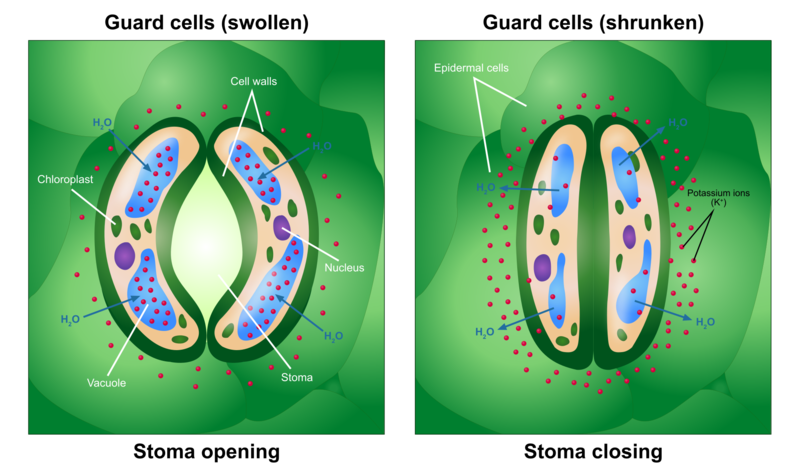9th Grade > Biology
TISSUES MCQs
Total Questions : 30
| Page 3 of 3 pages
Answer: Option A. ->
True
:
A
Aerenchyma is a special type of parenchyma tissue present in aquatic plants. They consists of a network of parenchyma cells which enclose large air cavities. These air cavities store gases. This makes the plant light and provides buoyancy.
:
A
Aerenchyma is a special type of parenchyma tissue present in aquatic plants. They consists of a network of parenchyma cells which enclose large air cavities. These air cavities store gases. This makes the plant light and provides buoyancy.
Answer: Option A. ->
Opening and closing of stomata
:
A
:
A
Guard cells are kidney shaped cells that surrounds the stomata. They control the opening and closing of the stomata. When the plant has an excess of water, the guard cells swell and create an opening for the exchange of gases. In dry conditions, the guard cells are flat and keep the stomata closed, inhibiting exchange of gases.
Answer: Option C. ->
glandular epithelium
:
C
A portion of the epithelial tissue folds inward, and forms a multicellular gland. This is called glandular epithelium. This secrete substances at the epithelial surface.
:
C
A portion of the epithelial tissue folds inward, and forms a multicellular gland. This is called glandular epithelium. This secrete substances at the epithelial surface.
Answer: Option B. ->
adipose tissue
:
B
Adipose tissue is present below the skin and between internal organs. It is a fat storing connective tissue. This layer acts as an insulating layer and shock absorber, protecting the internal organs.
:
B
Adipose tissue is present below the skin and between internal organs. It is a fat storing connective tissue. This layer acts as an insulating layer and shock absorber, protecting the internal organs.
Answer: Option A. ->
striated muscles
:
A
:
A
Muscles that are under the conscious control of an individual are skeletal or striated muscles. For example, the muscles in our arms move only when we want. Such muscles are also called voluntary muscles.
Answer: Option A. ->
True
:
A
Xylem and phloem are two conducting tissues present in plants. Phloem transports food material from leaves to other parts of the plant body. It can conduct food in both directions. Xylem conducts minerals and water only in the upward direction i.e., from roots towards the stem.
:
A
Xylem and phloem are two conducting tissues present in plants. Phloem transports food material from leaves to other parts of the plant body. It can conduct food in both directions. Xylem conducts minerals and water only in the upward direction i.e., from roots towards the stem.
Answer: Option A. ->
Xylem fibres
:
A, C, and D
Xylem is a complex permanent plant tissue. It is involved in conduction of minerals and water from roots to other parts of the plant. It consists of xylem vessels, xylem tracheids, xylem fibres and xylem parenchyma. Whereas, phloem consists of sieve tubes, companion cells, phloem fibres and phloem parenchyma.
:
A, C, and D
Xylem is a complex permanent plant tissue. It is involved in conduction of minerals and water from roots to other parts of the plant. It consists of xylem vessels, xylem tracheids, xylem fibres and xylem parenchyma. Whereas, phloem consists of sieve tubes, companion cells, phloem fibres and phloem parenchyma.
Answer: Option C. ->
fluid connective tissue
:
C
There are two types of fluid connective tissues- blood and lymph. Blood circulates throughout the body supplying oxygen, nutrients and removes carbon dioxide and metabolic wastes from the body. Lymph on the other hand, carries materials from the blood stream into tissues and vice-versa. It also kills the pathogens, faciliated by the lymphocytes.
:
C
There are two types of fluid connective tissues- blood and lymph. Blood circulates throughout the body supplying oxygen, nutrients and removes carbon dioxide and metabolic wastes from the body. Lymph on the other hand, carries materials from the blood stream into tissues and vice-versa. It also kills the pathogens, faciliated by the lymphocytes.
Answer: Option A. ->
Blood - Protection against infection
:
A and D
∙ Blood is a fluid connective tissue. The fluid component of blood is called plasma, while the cellular components consists of RBCs, WBCs and platelets. WBCs help to protect the body against infections.
∙ Muscular tissues help in voluntary movement (e.g. walking) and involuntary movement (e.g. peristalsis).
∙ Nerve fibres pass on information by transmitting electrical signals.
∙ Bones are connective tissue which provide the skeletal framework and protect vital organs of the body.
:
A and D
∙ Blood is a fluid connective tissue. The fluid component of blood is called plasma, while the cellular components consists of RBCs, WBCs and platelets. WBCs help to protect the body against infections.
∙ Muscular tissues help in voluntary movement (e.g. walking) and involuntary movement (e.g. peristalsis).
∙ Nerve fibres pass on information by transmitting electrical signals.
∙ Bones are connective tissue which provide the skeletal framework and protect vital organs of the body.
















